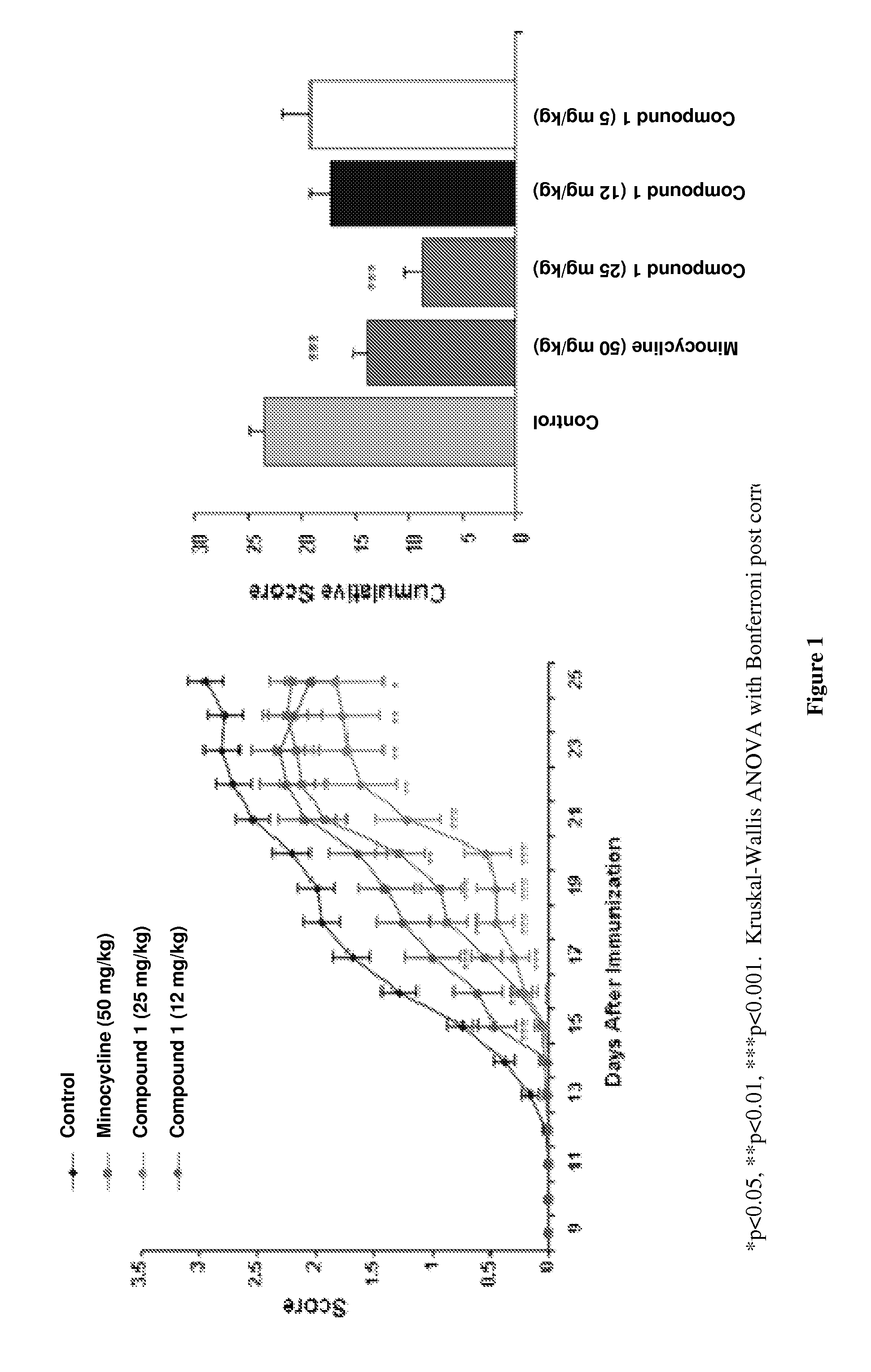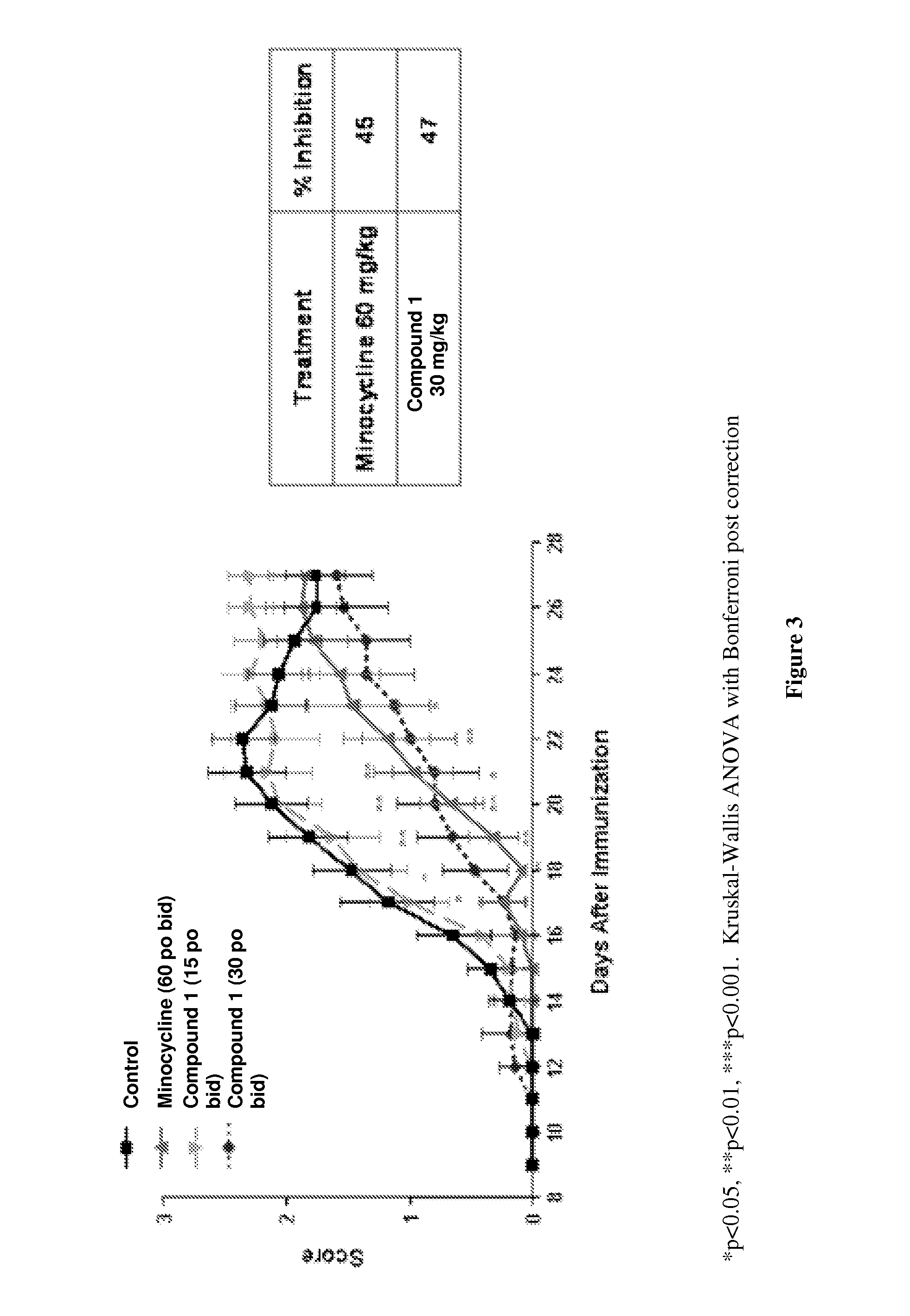Tetracycline compounds for treating neurodegenerative disorders
a neurodegenerative disorder and tetracycline technology, applied in the field of neuroprotective characteristics of tetracyclines, can solve the problems of undesirable photosensitivity reactions, tissue staining, gastrointestinal upset, etc., and achieve the effects of treating, preventing, or ameliorating multiple sclerosis, treating, or preventing multiple sclerosis
- Summary
- Abstract
- Description
- Claims
- Application Information
AI Technical Summary
Benefits of technology
Problems solved by technology
Method used
Image
Examples
example 1
[0084]A series of recent clinical studies were conducted using the tetracyclines minocycline and doxycycline for the treatment of MS. When administered at a typical antibacterial dose (200 mg / day), minocycline decreased the number of gadolinium-enhancing MRI lesions by 93%, decreased the relapse rate by 79%, and prevented worsening of disability in MS (Table 1). Mild nausea in some patients was the only adverse event noted. In additional, doxycycline in combination with IFN-β and minocycline in combination with glatiramer acetate were shown to significantly decrease lesion counts and disability scores with no increase in adverse effects. In the latter study the combination treatment was more effective than glatiramer acetate alone.
TABLE 1% Relapses% lesioneductionreductionpotential side effectsadministrationCOPAXONE ®3065Infection, shaking hands,daily injectionpainAVONEX ®3257Infection, seizure liver3× / wk injectionproblems, painTYSABRI ®6883Liver damage, fatigue, fatalmonthlyPMLinje...
example 2
[0085]Compound 1 showed improved efficacy over minocycline and other approved MS therapies in accepted animal models of MS and neuroprotection (Table 2). In addition, compound 1 has a lower propensity to cause tissue staining than minocycline and has demonstrated an improved safety and pharmacokinetic profile over minocycline in pre-clinical toxicology and ADME testing.
TABLE 2% Inhi-% Inhi-% Inhi-% Inhi-bitionbitionbitionbitionClinicalInflam-Demyel-AxonCompoundScoremationinationLossFingolimod*89596960Minocycline*40433438Compound 1*65746970IFN-β382829Glatiramer acetate7574*p
example 3
[0086]The inhibitory activity of Compound 1 was characterized in both mouse and rat models of EAE. Mice were immunized s.c. with myelin oligodendrocyte glycoprotein (MOG) peptide 35-55 in CFA and later injected i.v. with Pertussis toxin. Mice were randomized at day 10 and given compound i.p. Compounds were subsequently administered daily and the animals assessed for clinical score. Mice were scored as follows: 0=no disease; 1=limp tail; 2=paralysis of one or both hind limbs; 4=paralysis of both hind- and forelimbs. Lewis rats were immunized s.c. on day 1 with guinea pig myelin basic protein (MBP) emulsified in CFA. Rats were dosed daily i.p. with compound starting day 9. Rats were scored daily and cumulative scores were determined by adding the average daily scores over the experimental period.
[0087]The score-dose response of EAE inhibition is shown for Compound 1 in FIG. 1 (C57BL / 6 mouse model) and FIG. 2 (MBP-induced Lewis rat EAE model). The average daily scores+ / −SEM and the cum...
PUM
 Login to View More
Login to View More Abstract
Description
Claims
Application Information
 Login to View More
Login to View More - R&D
- Intellectual Property
- Life Sciences
- Materials
- Tech Scout
- Unparalleled Data Quality
- Higher Quality Content
- 60% Fewer Hallucinations
Browse by: Latest US Patents, China's latest patents, Technical Efficacy Thesaurus, Application Domain, Technology Topic, Popular Technical Reports.
© 2025 PatSnap. All rights reserved.Legal|Privacy policy|Modern Slavery Act Transparency Statement|Sitemap|About US| Contact US: help@patsnap.com



